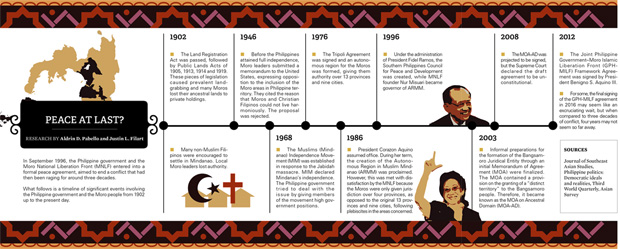In September 1996, the Philippine government and the Moro National Liberation Front (MNLF) entered into a formal peace agreement, aimed to end a conflict that had then been raging for around three decades.
What follows is a timeline of significant events involving the Philippine government and the Moro people from 1902 up to the present day.
1902
The Land Registration Act was passed, followed by Public Lands Acts of 1905, 1913, 1914 and 1919. These pieces of legislation caused prevalent land-grabbing and many Moros lost their ancestral lands to private holdings.
Many non-Muslim Filipinos were encouraged to settle in Mindanao. Local Moro leaders lost authority.
1946
Before the Philippines attained full independence, Moro leaders submitted a memorandum to the United States, expressing opposition to the inclusion of the Moro areas in Philippine territory. They cited the reason that Moros and Christian Filipinos could not live harmoniously. The proposal was rejected.
1968
The Muslims (Mindanao) Independence Movement (MIM) was established in response to the Jabidah massacre. MIM declared Mindanao’s independence. The Philippine government tried to deal with the issue by giving members of the movement high government positions.
1976
The Tripoli Agreement was signed and an autonomous region for the Moros was formed, giving them authority over 13 provinces and nine cities.
1986
President Corazon Aquino assumed office. During her term, the creation of the Autonomous Region in Muslim Mindanao (ARMM) was proclaimed. However, this was met with dissatisfaction by the MNLF because the Moros were only given jurisdiction over four provinces, as opposed to the original 13 provinces and nine cities, following plebiscites in the areas concerned.
1996
Under the administration of President Fidel Ramos, the Southern Philippines Council for Peace and Development was created, while MNLF founder Nur Misuari became governor of ARMM.
2003
Informal preparations for the formation of the Bangsamoro Juridical Entity through an initial Memorandum of Agreement (MOA) were finalized. The MOA contained a provision on the granting of a “distinct territory” to the Bangsamoro people. Therefore, it became known as the MOA on Ancestral Domain (MOA-AD).
2008
The MOA-AD was projected to be signed, but the Supreme Court declared the draft agreement to be unconstitutional.
2012
The Joint Philippine Government–Moro Islamic Liberation Front (GPH-MILF) Framework Agreement was signed by President Benigno S. Aquino III.
For some, the final signing of the GPH-MILF agreement in 2016 may seem like an excruciating wait, but when compared to three decades of conflict, four years may not seem so far away.
SOURCES: Journal of Southeast Asian Studies, Philippine politics: Democratic ideals and realities, Third World Quarterly, Asian Survey




